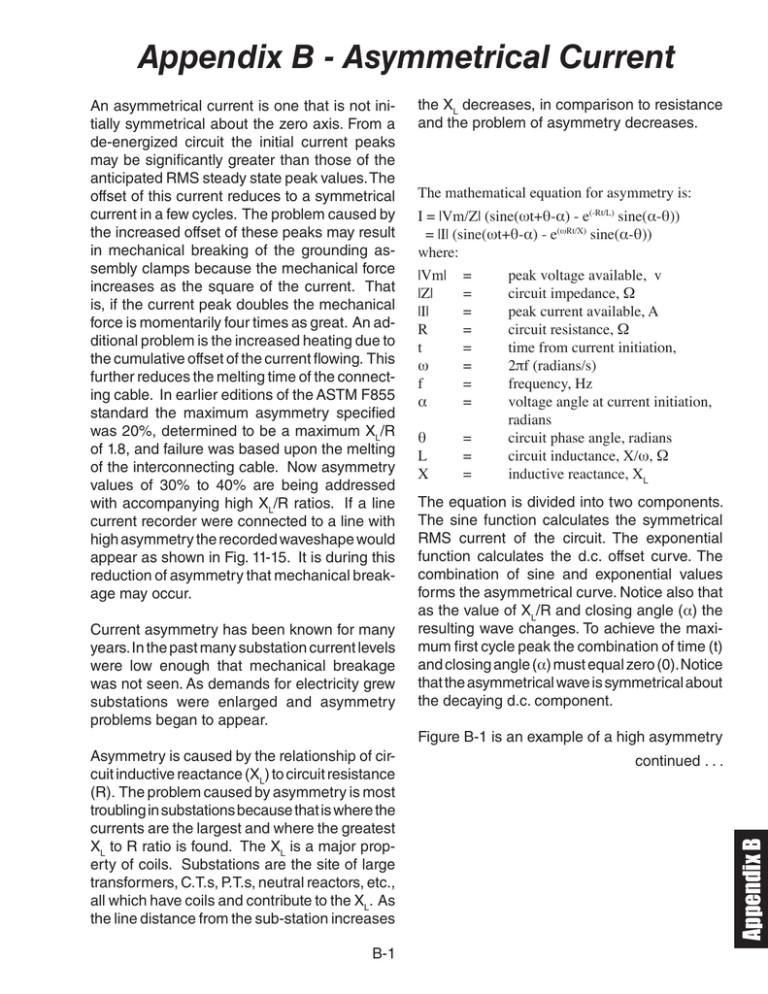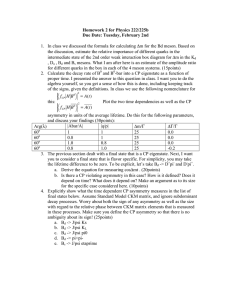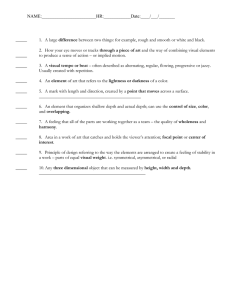Appendix B - Asymmetrical Current
advertisement

Appendix B - Asymmetrical Current Current asymmetry has been known for many years. In the past many substation current levels were low enough that mechanical breakage was not seen. As demands for electricity grew substations were enlarged and asymmetry problems began to appear. Asymmetry is caused by the relationship of circuit inductive reactance (XL) to circuit resistance (R). The problem caused by asymmetry is most troubling in substations because that is where the currents are the largest and where the greatest XL to R ratio is found. The XL is a major property of coils. Substations are the site of large transformers, C.T.s, P.T.s, neutral reactors, etc., all which have coils and contribute to the XL. As the line distance from the sub-station increases B-1 the XL decreases, in comparison to resistance and the problem of asymmetry decreases. The mathematical equation for asymmetry is: I = |Vm/Z| (sine(ωt+θ-α) - e(-Rt/L) sine(α-θ)) = |I| (sine(ωt+θ-α) - e(ωRt/X) sine(α-θ)) where: |Vm| = peak voltage available, v |Z| = circuit impedance, Ω |I| = peak current available, A R = circuit resistance, Ω t = time from current initiation, ω = 2πf (radians/s) f = frequency, Hz α = voltage angle at current initiation, radians θ = circuit phase angle, radians L = circuit inductance, X/ω, Ω X = inductive reactance, XL The equation is divided into two components. The sine function calculates the symmetrical RMS current of the circuit. The exponential function calculates the d.c. offset curve. The combination of sine and exponential values forms the asymmetrical curve. Notice also that as the value of XL/R and closing angle (α) the resulting wave changes. To achieve the maximum first cycle peak the combination of time (t) and closing angle (α) must equal zero (0). Notice that the asymmetrical wave is symmetrical about the decaying d.c. component. Figure B-1 is an example of a high asymmetry continued . . . Appendix B An asymmetrical current is one that is not initially symmetrical about the zero axis. From a de-energized circuit the initial current peaks may be significantly greater than those of the anticipated RMS steady state peak values. The offset of this current reduces to a symmetrical current in a few cycles. The problem caused by the increased offset of these peaks may result in mechanical breaking of the grounding assembly clamps because the mechanical force increases as the square of the current. That is, if the current peak doubles the mechanical force is momentarily four times as great. An additional problem is the increased heating due to the cumulative offset of the current flowing. This further reduces the melting time of the connecting cable. In earlier editions of the ASTM F855 standard the maximum asymmetry specified was 20%, determined to be a maximum XL/R of 1.8, and failure was based upon the melting of the interconnecting cable. Now asymmetry values of 30% to 40% are being addressed with accompanying high XL/R ratios. If a line current recorder were connected to a line with high asymmetry the recorded waveshape would appear as shown in Fig. 11-15. It is during this reduction of asymmetry that mechanical breakage may occur. waveform. It takes approximately 15 cycles to return to near symmetrical current. If mechanical breakage is going to occur it will probably be within the first 1 to 5 cycles. Utilities must evaluate their sites and provide protective grounding assemblies that have been tested and rated for use under these conditions, if deemed necessary. The current ASTM F855 standard addresses this and provides testing procedures and required values. Some substations remain sufficiently low in current that mechanical breakage may not be a problem. This is not something easily determined in the field. It must be considered prior to entering a substation site for maintenance. Asymmetrical Current (30 kA, X/R=30) Figure B-1 If the XL to R ratio is small the asymmetry decreases to a proper RMS shape in a few cycles. If the ratio is large it may take as many as 20 to 30 cycles to become a symmetrical current. Figure B-2 illustrates the small value of maximum asymmetry allowed in the past. Notice that the waveshape returns to a symmetric shape in approximately 1 cycle. Asymmetrical Current (30 kA, X/R=1.8) Figure B-2 B-2


